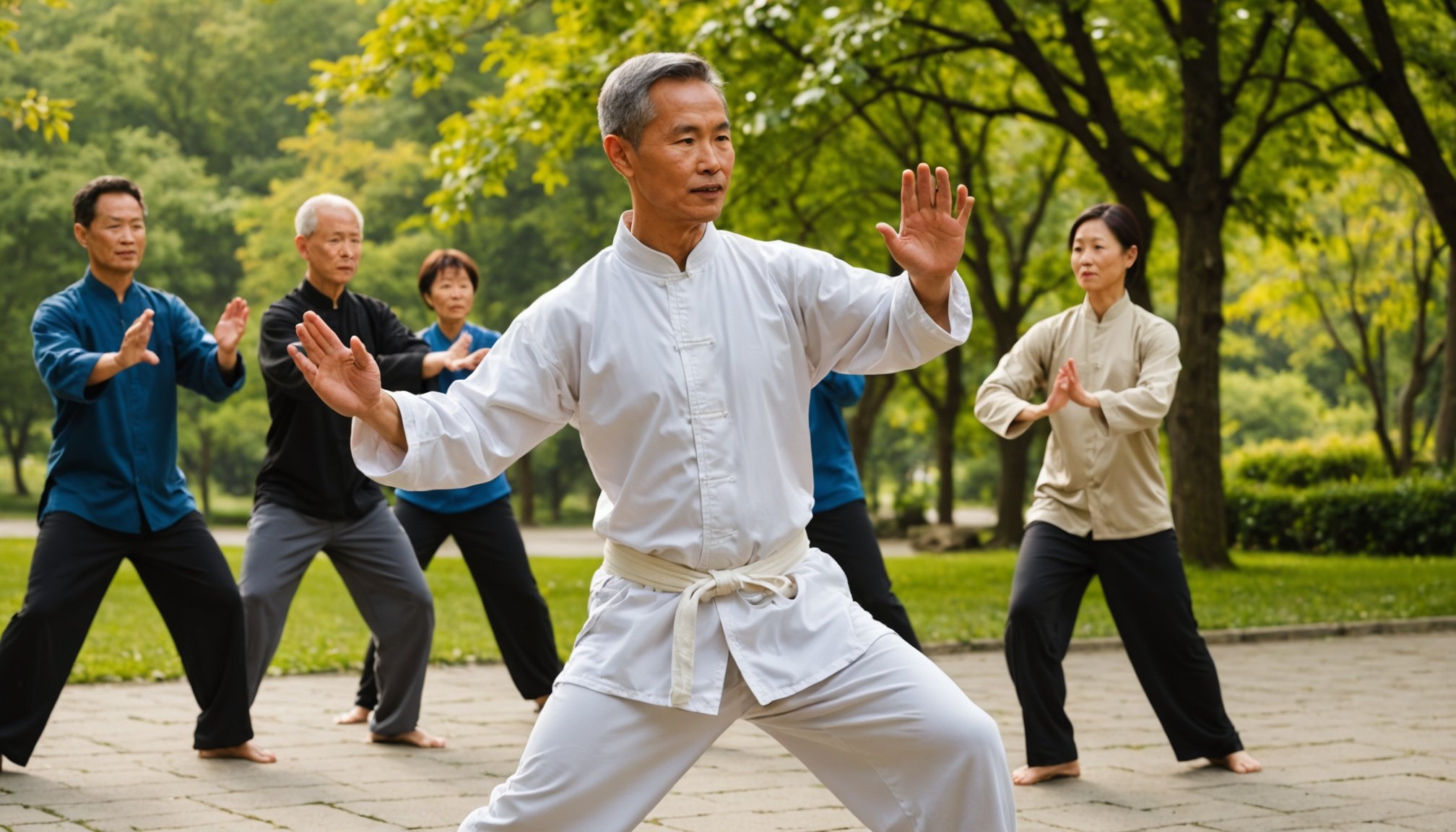Overview of Tai Chi
Delve into the world of Tai Chi, an ancient martial art with roots tracing back to China. This practice, often characterized by its slow and deliberate movements, is designed to balance the body’s energy, known as “qi”. Initially developed for self-defense, Tai Chi has evolved into a practice focused on health and relaxation, blending exercise and meditation in a harmonious way.
At the core of Tai Chi are fundamental principles that emphasize relaxation, balance, and the integration of mind and body. The movements are gentle, fluid, and circular, ensuring that practitioners remain relaxed rather than tense. These movements follow patterns which require attention and focus, allowing participants to achieve both mental clarity and physical dexterity.
Have you seen this : Boosting Cognitive Wellness: Effective Nutritional Tactics for Seniors with Mild Cognitive Decline
Philosophically, Tai Chi is rooted in Taoist principles, emphasizing unity and balance with the natural world. Its health benefits extend beyond the physical domain, often described as fostering improvements in mental well-being. Tai Chi’s gentle nature makes it accessible for individuals of all ages and fitness levels, promoting longevity by enhancing both well-being and vitality. Whether practiced for its philosophical roots or its health benefits, Tai Chi remains a revered form of exercise and mindfulness practice worldwide.
Benefits of Tai Chi for Joint Health
Tai Chi has a profound impact on joint health, providing a natural approach to managing joint pain and inflammation. Its gentle and fluid movements are designed to enhance flexibility and mobility, promoting a greater range of motion in affected areas. This makes Tai Chi particularly beneficial for individuals suffering from conditions like arthritis, where maintaining joint function is crucial.
Topic to read : Boosting Cognitive Wellness: Effective Nutritional Tactics for Seniors with Mild Cognitive Decline
Engaging in regular Tai Chi practice assists in reducing joint stiffness, thanks to its low-impact nature. Unlike more strenuous exercises, Tai Chi’s controlled movements ensure that there’s minimal strain on the joints, which is ideal for those with chronic pain. Notably, Tai Chi enhances the overall balance and stability of the body. This is essential for preventing falls, especially in older adults, as strong balance helps mitigate the risk of injuries.
Moreover, Tai Chi fosters a mind-body connection that encourages practitioners to become more aware of their body’s movements. This heightened awareness can lead to improved posture and alignment, further alleviating stress on the joints. Hence, incorporating Tai Chi into one’s routine could be a thoughtful addition for anyone seeking holistic methods to support joint health naturally.
Scientific Research and Evidence
In recent years, scientific studies have increasingly focused on Tai Chi, offering compelling insights into its numerous benefits. Research in this domain leverages empirical evidence to substantiate claims related to Tai Chi’s effectiveness.
Review of Key Studies
Several major studies have been conducted to validate Tai Chi’s health benefits. For instance, a study published in the Journal of Rheumatology highlighted Tai Chi’s positive impact on joint health, demonstrating significant reductions in joint pain and stiffness among participants. These findings have been supported by various researchers who affirm that consistent practice can lead to improvements in flexibility and mobility.
Experts analyzing these results often praise Tai Chi not just for physical benefits, but also for enhancing mental well-being. By integrating Tai Chi into their routines, participants in these studies often report improvements in balance and overall body stability, reinforcing the practice’s holistic impact. This breadth of benefits underscores Tai Chi’s potential as a multifaceted exercise, suitable for diverse health objectives. With mounting evidence, Tai Chi continues to be recognized within the medical community as a viable option for enhancing both physical and mental health.
Practical Tips for Incorporating Tai Chi
Embarking on a Tai Chi practice can be an enriching journey. For beginners, starting with simple exercises at home provides a convenient way to acquaint oneself with the basic principles. Engaging in routines like the 24-form Tai Chi sequence can promote relaxation and enhance mobility. It’s ideally performed daily, allowing practitioners to experience incremental benefits over time.
When seeking more structured guidance, consider finding local Tai Chi classes. These offer a supportive environment, where instructors can provide personalized corrections and tips to refine your movements. To find a suitable class, research instructors’ qualifications, inquire about their teaching style, and ensure it aligns with your goals. Participating in group settings also fosters camaraderie, enhancing the overall learning experience.
Integrating Tai Chi into your daily routine requires commitment. Establish a regular schedule, allotting specific time slots for practice. Early mornings or evenings, when the mind is calm, are optimal. Consistency is crucial, as regular practice cultivates a deeper connection with the discipline. Over time, such dedication not only enhances physical well-being but also enriches mental focus and clarity. By embracing these practical tips, you can seamlessly incorporate Tai Chi into your lifestyle, reaping its myriad benefits.
Resources and Community
Engaging in Tai Chi goes beyond personal practice; it’s about connecting with a supportive community and accessing valuable resources. Today’s digital age makes discovering online resources quite accessible. There are several platforms offering video tutorials and guided sessions, making it easier for practitioners to follow along and learn the movements accurately. Websites and apps cater to varying skill levels, offering structured courses from beginner to advanced, which helps tailor the experience to individual needs.
Online Resources
-
Recommended Websites and Apps: Many dedicated online platforms provide comprehensive Tai Chi courses. They often include instructional videos, which can be paused and rewatched, allowing for learning at one’s own pace.
-
Video Tutorials: Accessible tutorials provide visual guidance, essential for mastering Tai Chi’s intricate movements. These resources often include slow-motion videos for detailed understanding.
-
Connecting with Communities: Joining online Tai Chi groups or forums can significantly enhance your learning journey. Such platforms offer a space to exchange experiences, pose questions, and receive feedback from fellow enthusiasts.
Connecting with Tai Chi communities and support groups propels your journey from a solitary practice to a shared experience, fostering motivation and enriching your understanding of Tai Chi’s multifaceted benefits.



